There are many crochet rug patterns out there: square crochet rugs, round crochet rugs, doily type rugs…so many styles to choose from and each one unique in its own way. In this post, I would like to show you how to crochet a simple round rag rug using single crochet, half-double crochet, or double crochet stitches.
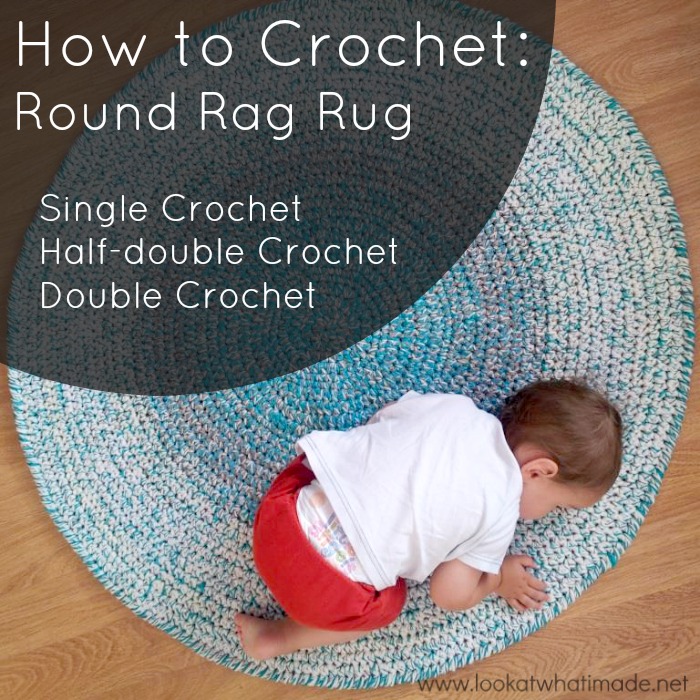
Instead of giving you one specific crochet rug pattern, I want to help you understand the maths and principles behind making a (flat) round rag rug, so that you can make as many of them as you wish, adapting them as it suits you.
Below, you will find instructions for a basic circle rag rug using single crochet, half-double crochet or double crochet stitches, together with some tips about what to do if your rug warps in any way.
Before we get to the instructions, though, let’s quickly talk about materials!
Different Materials
Jersey Cotton (T-shirt Yarn) Crochet Rug
This Rug was made using jersey cotton cut into 2.5 cm (1″) strips. You can either buy some t-shirt yarn or make your own following my tutorial for making fabric yarn.
I had to alter the number of increases in the pattern quite a bit as I went because some of the fabric pulled into yarn quite easily while other colours just did not want to “tube”. Also, the red and blue (which tubed well – is that even a word??) were way more elastic than the other colours, which made a difference as well.
If you use an elastic material, it is very difficult to keep your tension even. This is why I think that understanding the logic behind the rug (how to get rid of ripples and curling) can prevent this EASY project from turning into a nightmare.
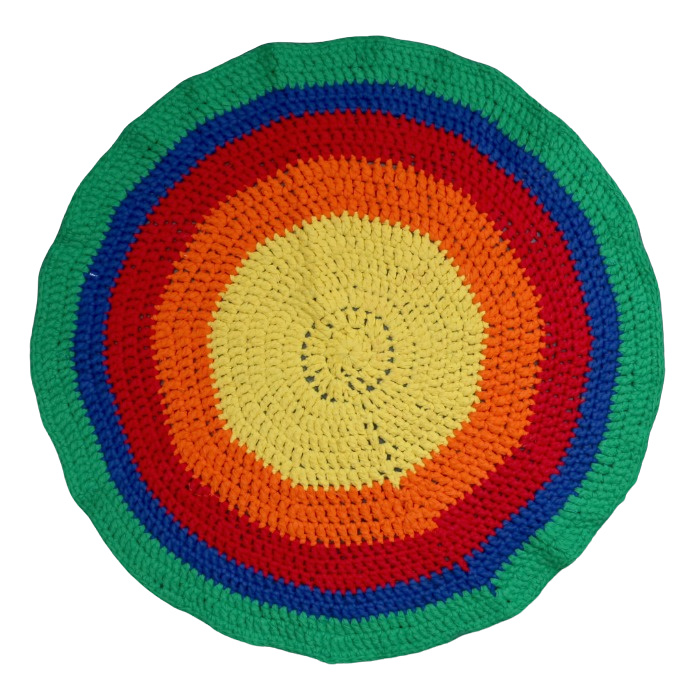
Cotton/Linen Crochet Rug
You can make your own non-elastic fabric yarn by cutting a duvet cover or some sheets into strips. As with the t-shirt yarn, 2.5 cm (1″) strips work the best, being neither too thick (difficult to work with) or too thin (might tear easily).
I prefer using a duvet cover as it is already a tube (once you’ve cut the bottom off) and can be cut in the same way as the t-shirt yarn above, just on a way bigger scale.
If you have separate strips of fabric that you would like to link together, THIS TUTORIAL by Crochet Is The Way has some very clear photos on joining strips of fabric to each other without sewing.
The advantage of using non-stretch fabric yarn is that it acts very much like yarn would in that it does not buckle and ‘bowl’ quite as easily as jersey cotton. The disadvantage of using non-stretch fabric for your crochet rug is that it does not stretch AT ALL. So where yarn would give you a little bit of stretch, making it easy to get into stitches on subsequent rounds, non-stretch fabric yarn does not budge. To avoid the resulting finger-cramp, remember to loosen your tension when working with non-stretch fabric yarn. You will save yourself a lot of cursing!
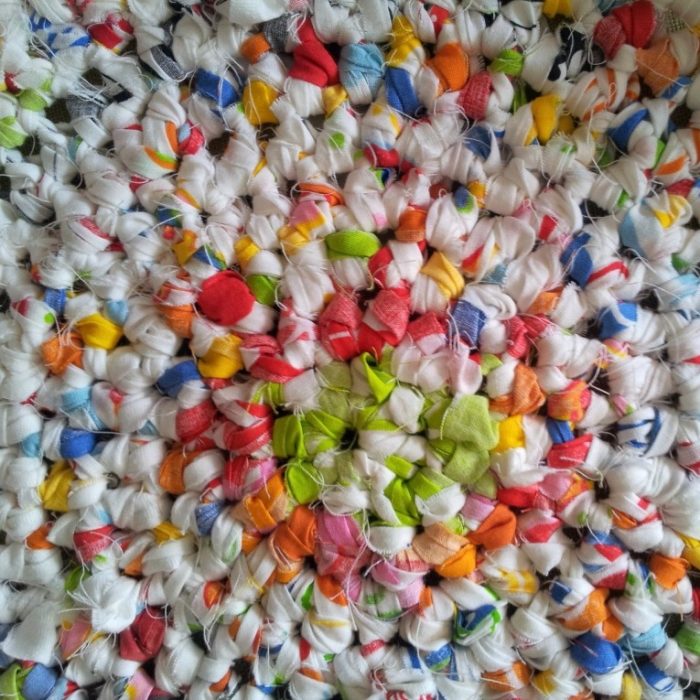
Wool/Yarn Crochet Rug
Wool/yarn is by far the easiest material to use when making a crochet rag rug. It also affords a lot of opportunities for shading or ‘painting with yarn’, as I like to call it.

If you want a project that grows at the speed of light, that doesn’t tax your brain, and that uses A LOT of stash yarn and scraps, then a crochet rug made from yarn is just the thing for you.
You will need the equivalent of 4 to 8 strands of double knit yarn (or 3 to 5 strands of chunky yarn) and a good tv series.
It doesn’t matter if you mix and match fibres. In fact, I like using a bit of cotton, wool, and acrylic in each rug. I think it creates a nice balance between affordability, durability, and softness. My favourite wool/acrylic rug (pictured below) now lives in New Zealand with my sister. She has been using it for more than six years and it still looks great! You can find the details of this specific rug HERE.
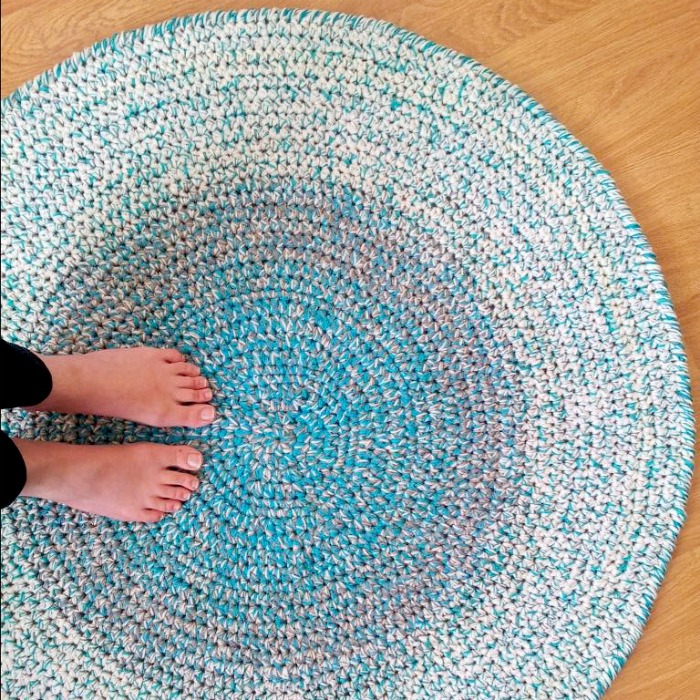
How to Crochet a Round Rag Rug
©Dedri Uys 2011. All Rights Reserved. Updated June 2020.
Index
- Notes
- Basic Single Crochet Round Rag Rug
- Basic Half-double Crochet Round Rag Rug
- Basic Double Crochet Round Rag Rug
- To Continue
- My Rug Curls – What Now?
- My Rug Ripples – What Now?
- To Finish
Materials
- Yarn Options:
- T-shirt yarn (like Premier Craft-Tee Yarn
)
- Non-stretch fabric yarn
- Wool/yarn (lots and lots of strands held together)
- T-shirt yarn (like Premier Craft-Tee Yarn
- Hook Options:
- Strong arms!
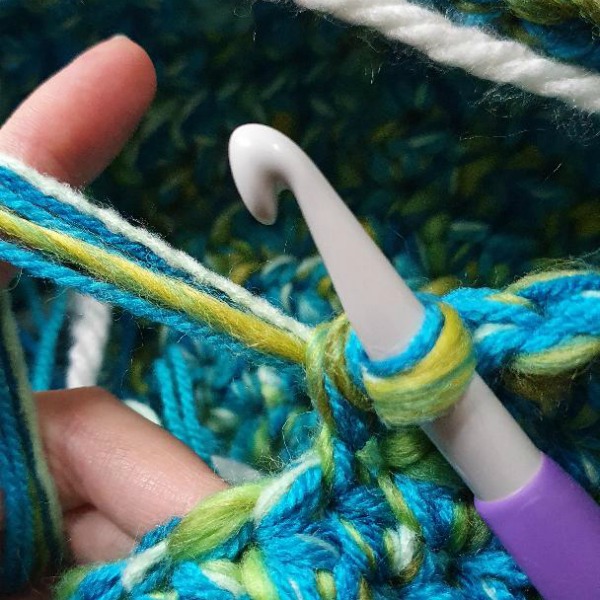
Abbreviations
US Terminology Used – US/UK Conversion Chart HERE
- Ch – Chain
- Dc – Double Crochet
- Hdc – Half-double Crochet
- Sc – Single Crochet
- Sl st – Slip Stitch
- St/s – Stitch/stitches
- () – Repeat all instructions between parentheses the number of times specified.
Notes
Make three or four rounds and then assess whether or not you need to change the number of increases in each round. This will depend on the thickness and elasticity of your yarn of choice, as well as your personal tension and hooking style.
- If your rug curls (bowls), try starting with one or two more stitches (and one or two more increases per round).
- If your rug ripples (waves), try starting with one or two fewer stitches (and one or two fewer increases per round).
If you increase/decrease the number of stitches in the initial round, it will affect the number of increases in each round. If you start with 5 sts in the first round, for example, you will repeat the pattern between parentheses 5 times in every subsequent round, and your total number of sts will be multiples of 5. If you start with 7 sts in the first round, you will repeat the pattern between parentheses 7 times in each round, making your total number of sts a multiple of 7.
These instructions are written for working in a spiral, which is my preferred method. Please see THIS TUTORIAL if you need any help with that.
I suggest using a Running Stitch Marker (as highlighted in the linked tutorial above) to keep track of the start and end of each round.
Basic Single Crochet Round Rag Rug
- Initial Number of Stitches: 6
- Increases Per Round: 6
- To Start: Ch 2.
Round 1: Make 6 sc into the second ch from the hook. {6 sc}
Round 2: Make 2 sc in each st around. {12 sc}
Round 3: (Make 2 sc in the next st, sc in the next st) 6 times. {18 sc}
Round 4: (Make 2 sc in the next st, sc in the next 2 sts) 6 times. {24 sc}
Round 5: (Make 2 sc in the next st, sc in the next 3 sts) 6 times. {30 sc}
See To Continue below.
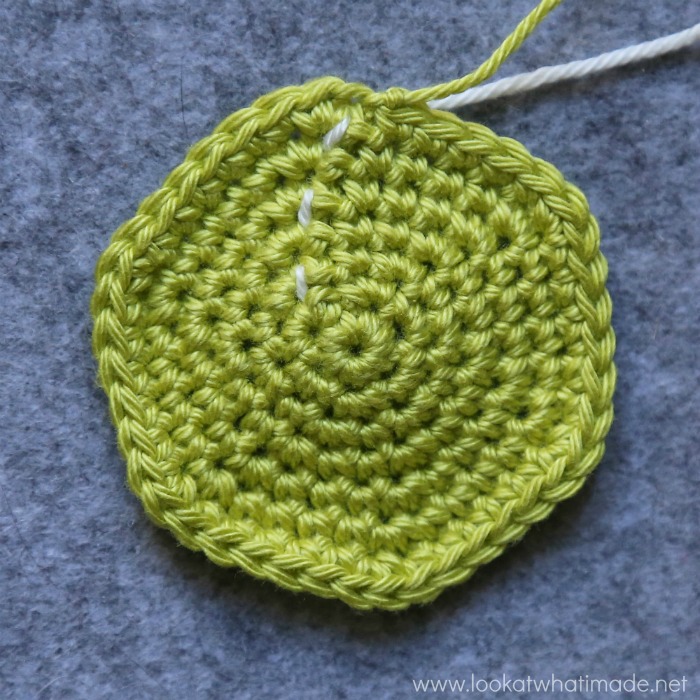
Basic Half-double Crochet Round Rag Rug
(This is my favourite stitch for making rugs)
- Initial Number of Stitches: 10
- Increases Per Round: 10
- To Start: Ch 4. Join to the fourth ch from the hook with a sl st to form a ring.
Note: Generally, people prefer to make hdc circles with 8 or 9 starting stitches/increases per round, with 9 being more mathematically accurate. For rugs, I prefer using 10 because it is easier to correct for rippling (too many stitches for the circumference) than it is to correct for curling (too few stitches for the circumference).
Round 1: Ch 1 (doesn’t count as a st). Make 10 hdc into the ch-4 ring. {10 hdc}
Round 2: Make 2 hdc in each st around. {20 hdc}
Round 3: (Make 2 hdc in the next st, hdc in the next st) 10 times. {30 hdc}
Round 4: (Make 2 hdc in the next st, hdc in the next 2 sts) 10 times. {40 hdc}
Round 5: (Make 2 hdc in the next st, hdc in the next 3 sts) 10 times. {50 hdc}
See To Continue below.
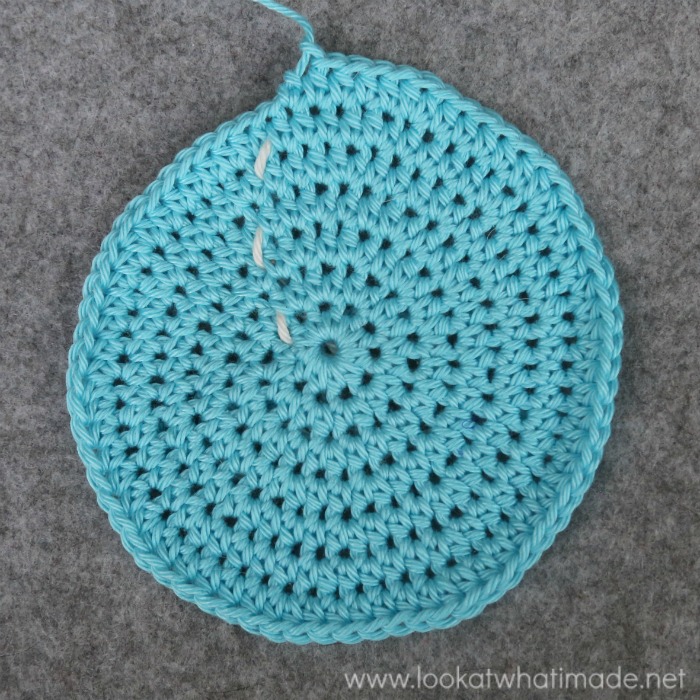
Basic Double Crochet Round Rag Rug
- Initial Number of Stitches: 12
- Increases Per Round: 12
- To Start: Ch 4. Join to the fourth ch from the hook with a sl st to form a ring.
Round 1: Ch 2 (doesn’t count as a st). Make 12 dc into the ch-4 ring. {12 dc}
Round 2: Make 2 dc in each st around. {24 dc}
Round 3: (Make 2 dc in the next st, dc in the next st) 12 times. {36 dc}
Round 4: (Make 2 dc in the next st, dc in the next 2 sts) 12 times. {48 dc}
Round 5: (Make 2 dc in the next st, dc in the next 3 sts) 12 times. {60 dc}
See To Continue below.
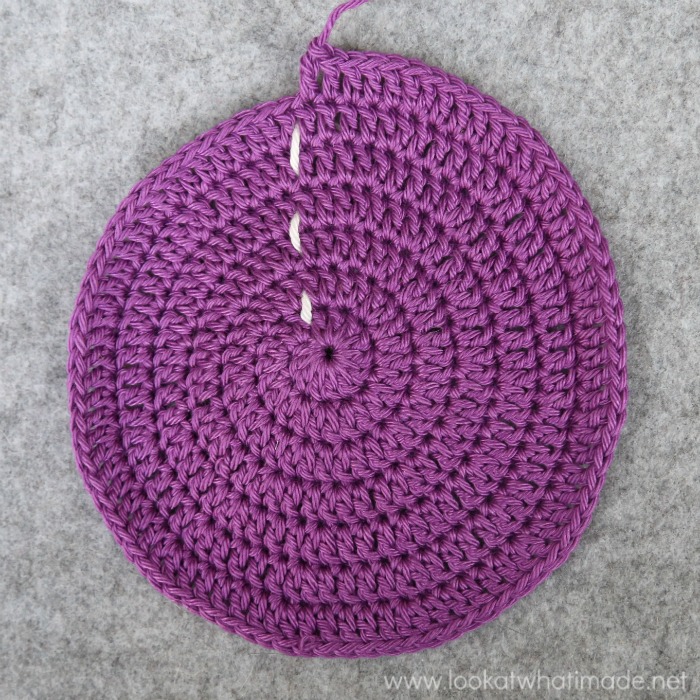
To Continue
You should now see a pattern emerging. In every round, the number of stitches between increases has increased by one, with the number of increases remaining the same as the number of stitches in the first round. Continue making your rug, increasing the number of stitches between increases by one in every round. I suggest laying your rug out on the floor every 2-3 rounds to check whether it is still flat. If it is either curling or rippling, you will need to correct it before it gets worse. I will explain how to go about doing that below.
My Rug Curls – What Now?
If the edges of your rug curl up into a bowl shape, it indicates that your final round does not have enough stitches for the circumference of your circle. You will, therefore, need to add more increases.
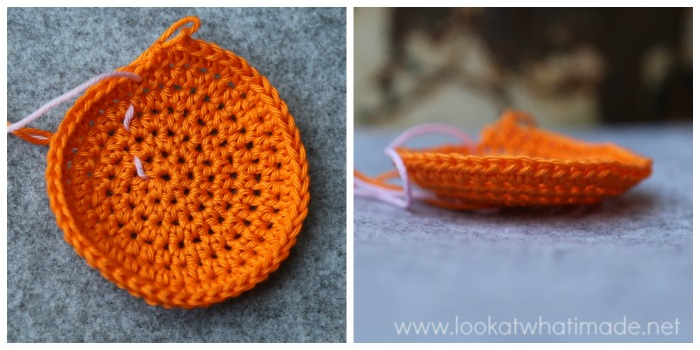
Before you do anything, though, try to flatten your work (works best if you place the rug on a carpeted surface and ‘iron’ it out with your hands). If you are not able to flatten it at all, you will need to frog (rip out) the last round or two until you are just about able to flatten it. If/when you ARE able to flatten it, continue with the instructions below.
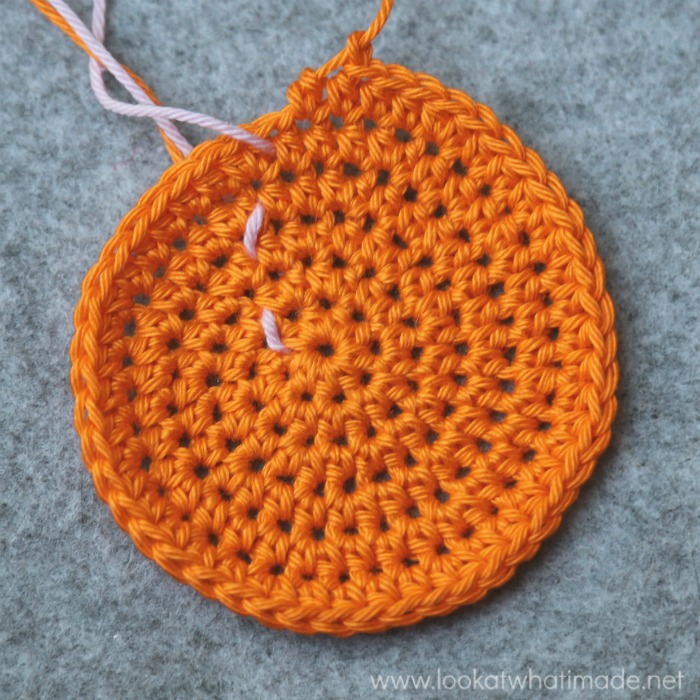
Curling Circle Flattened Out
Now double the increases for the next round only. In other words, if you made 6 increases in all your rounds so far, make 12 increases in the next round. Space these increases out evenly. In the image below, you can see the circled increases from the previous round. The arrows show the increases in the last round, with extra increases falling between the increases from the previous round.
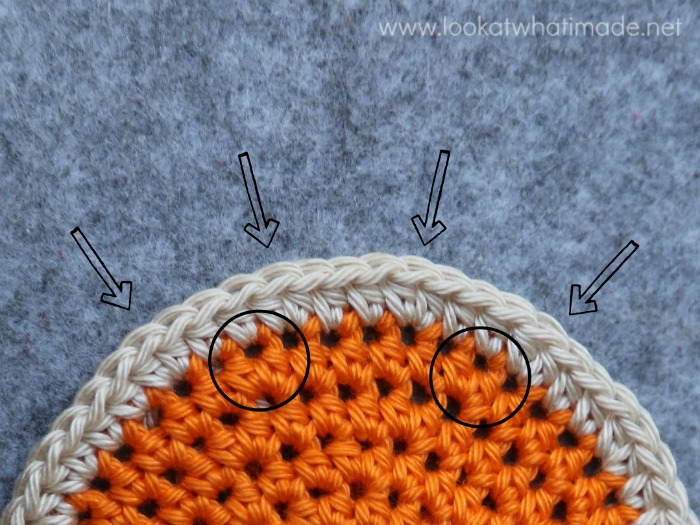
Double the Number of Increases to Flatten a Curling Crochet Circle
Check your rug again by flattening it out on the floor. If it lies flat now (which it should do), continue with your rug, reverting back to the standard number of increases per round. If it doesn’t lie flat yet, you can either do another double-increase round or frog back an extra round and try again.
Remember to check your rug every few rounds to avoid a lumpy bumpy rug!
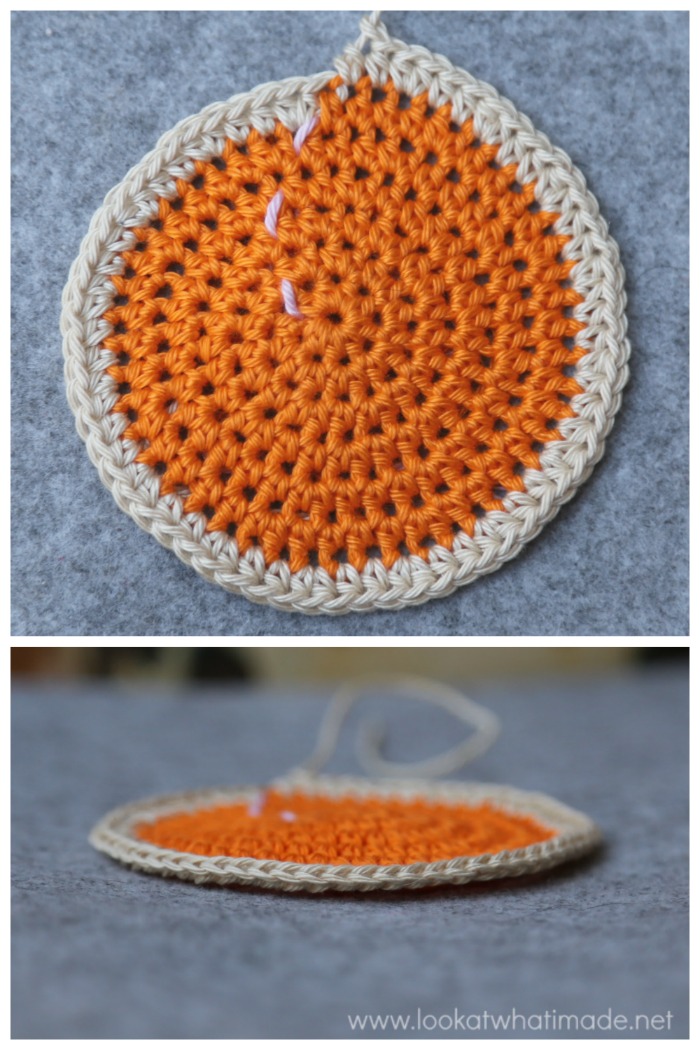
Curling Crochet Circle Fixed by Making a Double-increase Round.
My Rug Ripples – What Now?
If your rug ripples, it indicates that your final round has too many stitches for the circumference of your circle. You will, therefore, need to increase the size of the rug without adding any more increases.
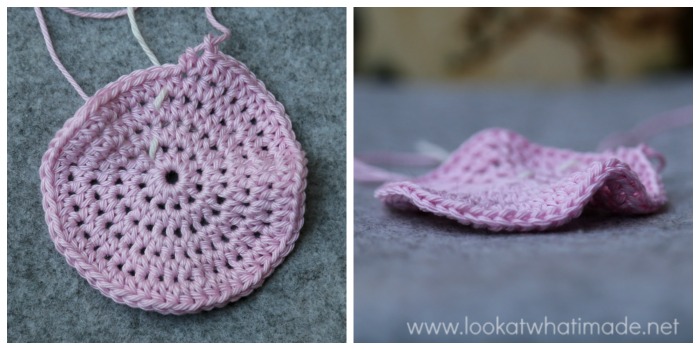
Before you do anything, though, try to flatten your work (works best if you place the rug on a carpeted surface and ‘iron’ it out with your hands). If you are not able to flatten it at all, you will need to frog (rip out) the last round or two until you are just about able to flatten it. If/when you ARE able to flatten it, continue with the instructions below.

Rippling Circle Flattened Out
Now crochet the next round only without any increases. In other words, make a sc/hdc/dc in each stitch around. The stitch count for this round will be the same as for the previous round. Of the two fixes, this is by far the easiest. In the image below, you can see that the last round is a no-increase round.
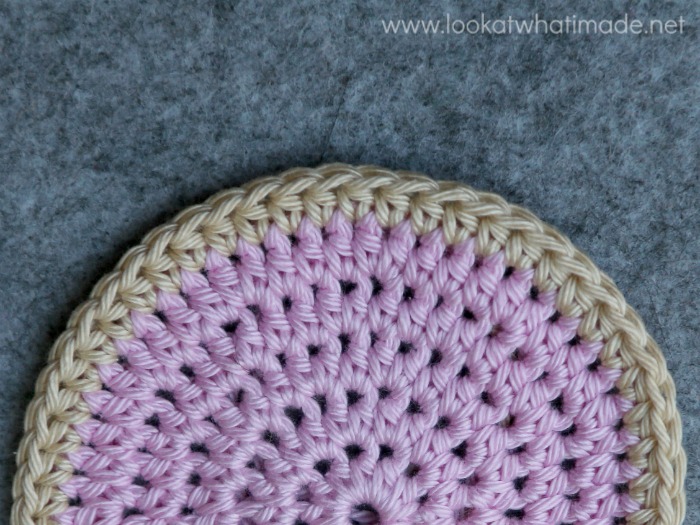
Make a No-increase Round to Flatten a Rippling Crochet Circle
Check your rug again by flattening it out on the floor. If it lies flat now (which it should do), continue with your rug, reverting back to the standard number of increases per round. If it doesn’t lie flat yet, you can either do another no-increase round or frog back an extra round and try again.
Remember to check your rug every few rounds to avoid a lumpy bumpy rug!
To Finish
When your rug is as big as you want it to be, finish off as follows:
- Single Crochet Rug: Sl st in the next st, fasten off, and work away your ends.
- Half-double Crochet Rug: Sc in the next st, sl st in the next st. Fasten off and work away your ends.
- Double Crochet Rug: Hdc in the next st, sc in the next st, sl st in the next st. Fasten off and work away your ends.
At this point, your rug is all done and ready to be used… OR you could add an edging round. I like adding edging rounds. For me, they make the rug feel finished :) I have two favourites, which I will share below.
Edging Rounds
Crab Stitch (Reverse Single Crochet)
I LOVE Crab Stitches. They take a bit of getting used to, but once you get into the swing of them, they are so meditative. The main reason I use them almost exclusively as a rug edging is that they create a nice heavy edge. They take up more space (width-wise) than regular stitches, so have a tendency to stretch your work. If I know that I am going to use them as an edging, I will end my rug with a no-increase round or two so that the last rounds curl slightly. That way the crab stitches won’t make my edge go wavy.
If you are not familiar with the Crab Stitch, please see This Video Tutorial.
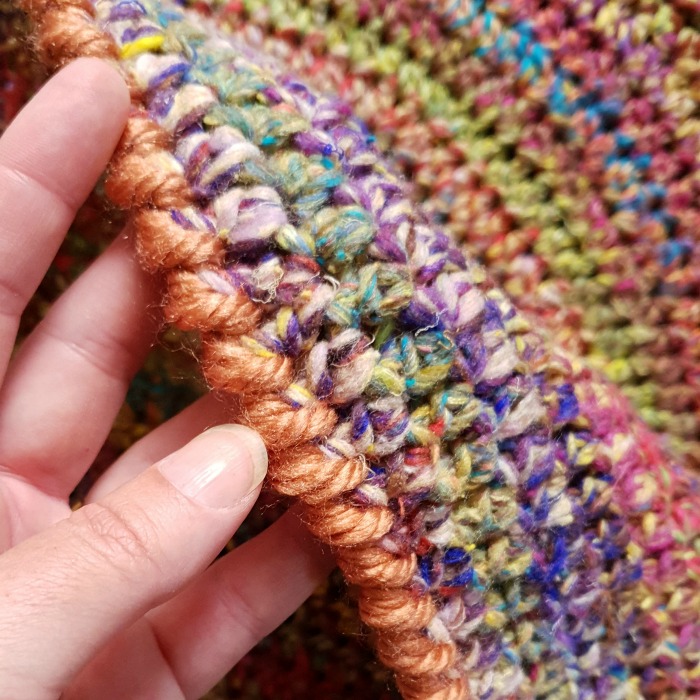
Back Post Double Crochet (BPdc)
I LOVE Back Post stitches. It is rare to find a design of mine that doesn’t include them. They work really well as an edging round for rugs, with the weight of the rug pushing them down into the ground for a snug fit against the floor. The photo below shows my Camping in Cornwall Rug, which ends on a BPdc round.
If you are not familiar with BPdc, please see This Video Tutorial.
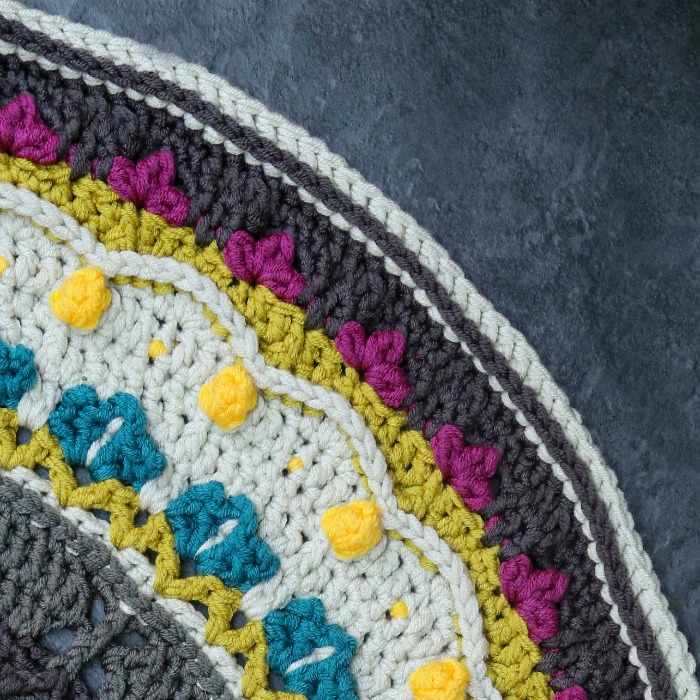
If you are concerned about your rug staying put once you’ve placed it on the floor, Interweave has some great suggestions for non-skid rug backing.
If you enjoy working with fabric yarn or multiple strands of yarn, have a look at my new book, Big Hook Rag Crochet (available in US terms by Lark Crafts on Amazon.com and in UK terms by Search Press on Amazon.co.uk). It contains 25 wonderful patterns (by a host of amazing designers). Each project is made using fabric yarn, but you can just as easily make them with multiple strands of wool/yarn.

This blog post contains affiliate links. I only link to products I personally use or would use. All opinions are my own.



Luch says
Thankyou, thankyou! This blog is brilliant! I attempted my first t-shirt rag rug last year completely by trial and much error, I wish I had found this tutorial! Excellent explanation of the science behind working with non-standard / non-uniform rag-yarns. It is so satisfying to be complimented for your own unique creation made from clothes, bedding, yarn remnants that have been cluttering up the home… 2022 I upcycled all my tatty old t-shirts, 2023 I’m going to get to work on upcycling some old bedding. Happy New Year!
Eloyne says
Thank you for the teaching/learning points. Very generous of you! I’m on my way to give it a try.
Karen Manasco says
Very nice! Thank you for sharing this tutorial. :-)
Ashley says
Hey, this rug is adorable! I am attempting my own, it was waving a bit, so I did a round with no increases. It helped a bit but it’s still a bit wavy. I’m doing another round with no increases again. If it is still a little wavy after that, am I able to decrease? Like skip every other stitch or would this make it even more wonky? I’m doing HDC :) thanks!!
Dedri Uys says
Hi Ashley. I would just keep going without increases until it lies flat again, and then start the increases again. If you are having to do more than 3 rounds without increasing, it is a sign that you have increased way too much for the height of your stitches. I regularly place my rugs on the floor while I am making them, checking to see if they are still flat or if I have to stretch them to get them flat. If I have to stretch them a lot to get them flat, I sometimes undo a round or two and do a round or two without increases. It’s better to have no increase rounds more often than to have many of them after each other.
I hope that helps.
Dedri
Cathy says
Would like to know if the rugs are slippery when put down on a wooden floor as they have no rubber backing. I once fell down a flight of stairs because of a rug at the top that did not have a good backing. Don’t want to do that again, but would love to make a rug.
Dedri Uys says
Cathy, that depends entirely on the yarn you use and the flooring you use it on. I have carpeted floors, so my rugs don’t slip. I never put them at the top of stairs because I am always fearful of slipping. You can find many ‘backing’ tutorials for safeguarding your rugs against this issue.
Anneliese says
Wow, that is great. You did a fantastic job to make things clear Thank you.! Much work in this blog.
Laura says
Love this! I have only just started crochet and this might sound like a stupid question but what size hook would you use for this kind of project? X
Dedri Uys says
I use a 10 mm hook for my rugs, but that depends on how many strands of yarn you use at once.
Bobbi says
Hello! Have you ever used Bernat Baby Blanket yarn to make a rug? It is a very thick ‘yarn’ (6 Super bulky) that feels like chenille. I want to make a round doily-like rug for the bathroom but I’m finding it tough to work with in a pattern. It wants to either wave or pull into a bowl. When worked it is pretty unforgiving…it is a ‘stout’ yarn for lack of a better word meaning you can’t smoosh a bunch of stitches into a small space like other yarns. I have yet to find a doily type rug pattern using it. I think your chart for increasing may help. It’s a great tool for working in the round regardless!! Thank you!
Dedri Uys says
Hi Bobbi. When I work with yarns that are quite unyielding, I generally just do a round rug, increasing or decreasing as needed. I find it too much trouble to follow a pattern when using a stiff yarn/rope and unless I am prepared to ‘redesign’ every round as needed, I steer well clear of anything complicated.
Sheila says
I just found this pattern. It is so pretty!! I am going to attempt my first rug for my first grandbaby. My question is how do you get the ombre pattern in your rug. It is beautiful and I would like to do it in a peachy color. Thanks , Sheila
Dedri Uys says
Hi Sheila.
Edited: I usually start with 8 strands of the same colour (different blues in this case) and then introduce one strand of a lighter shade every time one strand runs out (in this case cream and grey). I slowly go to creams until all my strands are some shade of cream/white. I hope that makes sense. For this specific rug I started with predominantly blues and 1 strand each of cream and grey. When all my blue ran out, I finished the round I was working on and made the crab stitch edge. For the crab stitch edge I used 1 strand each of blue and grey, and cream for the rest of the strands.
Katajojo says
Dedri, I didn’t understand your explanation of the color changes to Sheila. From the photo, you still have blue throughout, not just all creams as you stated in your expkanation. And it looks as though you started with blue, grey, and a cream, not just all blues.
1. Can you tell us exactly how many strands of each color you started with?
2. What do you mean, “when one color runs out?” All my skeins are new so they will run out at the same time. So, yes, i would like very explicit instructions on color changes as well.
3. Do you change one thread? 2? 3?
Sorry to be such a pain. Your crochet tutorial is brilliant. Would like a color tutorial as detailed as the stitch tutorial :) :) :)
Dedri Uys says
Hi,
Thank you for your query. The rug was made from scrap yarn, which is why there is no detailed colour tutorial. Making a scrap rag rug is not an exact science. You are correct that I started with blue, grey, and cream. I will amend my comment.
Because I used scrap yarn, I cannot give you an exact number of strands to use as it will depend on the weight you use. I use the equivalent of 6 strands of double knit (#3) yarn, which can 10 or more strands if you are using fingering weight or 4 strands if you are using worsted weight/chunky. Ir depends on your gauge and how dense you want your rug to be. Some of the balls I started with were full, others were only small balls, all in different weights, which is why I say to swap a new strand in as soon as one strand runs out.
You are correct that my rug has blue in the crabstitch round (I kept a bit of blue aside to use in the edge), but the last few stitches of the last round are all grey/cream.
If you want to replicate my rug with full skeins, you would need to start with 4 strands of blue, 1 strand of grey, and 1 strand of cream. Every 5 rounds or so you would need to cut one strand of blue and replace it with grey so that you have more and more grey strands and less and less blue ones. When you have 2 blue strands left, start swapping your grey yarn out for cream yarn every 4 or 5 rounds until you have 1 strand of grey left. Then swap one of your remaining 2 blue strands out for a cream strand. When your remaining blue strand runs out, swap it with another cream and finish the round. You can add more rounds if you want more cream on the outside. If you want to make a crab stitch round that contains blue, make sure that you keep half a skein of blue aside. Swap the blue in again and finish the crab stitch round.
This will not give you exactly the same rug as me, but it is the closest explanation I can give you, considering that I used different weights of scrap yarn at different points.
I hope you are now able to start making your rag rug.
Dedri
Katajojo says
Dedri,
THANK YOU! You really are a gem among crafters to be so helpful. I am a newbie to color blending, though a long-time :) crocheter. I do like a solid template to learn from, as a good instructional foundation is the only way I can eventually stray from it with confidence and create my own ideas. Thank you for your quick response and detail. Super grateful!
teri says
This is my first time making a rug, it is not just buckling it is wavy!?!?! What do I do????
Dedri Uys says
Teri, if it is wavy you need to increase less. The easiest way to do that is to work a round or two without any increases, and then continue with the increase pattern. If the waviness goes back quite a few rounds you need to frog back some. Have you got a photo? You can send it to me by using the “Contact Me” option right at the top of the page.
Mrs.I says
hi Dedri,first of all thanks alot about your v v important points…really i learned alot from your tutorial. .i want to ask you about something, every time when i crochet the round rag with hdc st the final shape is not totally round ther is som edges in the shape ..can u tell me where is the problem ..thanks
Dedri Uys says
Hi.
You can get rid of the octagonal shape by staggering your increases. By that I mean that you should do each alternate round’s increases between the previous round’s increases, not on top of them. So if your round is (hdc increase, 3 hdc) x 8, for example, your next round, instead of being (hdc increase, 4 hdc) x 8 will be: Make 2 hdc’s. (hdc increase, 4 hdc) x 7. Hdc increase, hdc in the last 2 st’s.
I hope that makes sense.
Dedri
Julie says
I have been searching for a pattern for years. I have attempted 5 or 6 now. Each one ends up with curly edges. My question is, do I have to undo a round before I do a round with no increases to fix the buckling edges or will it just fix itself?
Dedri Uys says
Hi Julie, do you mean wavy (like ruffles) or curly (like a bowl)?
When working a circle in the round with the correct increases, your last round will always curl up a bit. This should correct when you work the next round into it, as it will stretch the stitches a bit. But if you have gone a few rounds and all of them are either curling or waving, you have to undo.
If you want to avoid that last round curling, turn at the end of the last round so that the back of your work is facing you. Work a single crochet round (without increases) with the back facing you. This will make the “curl” point to the back of your work, which will be against the floor when your rug is being used. This makes for less of a trip-hazard. Alternatively (and this is my favourite way), make a crab stitch border. This is a) pretty, b) more weighty than a sc round, and c) gets rid of the curl.
I hope that helps.
sharon king says
good points to learn
Patricia Moore says
nice !!
anne says
Thank you very much for these useful advices!
Dedri Uys says
Glad you like it, Anne x